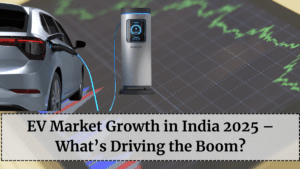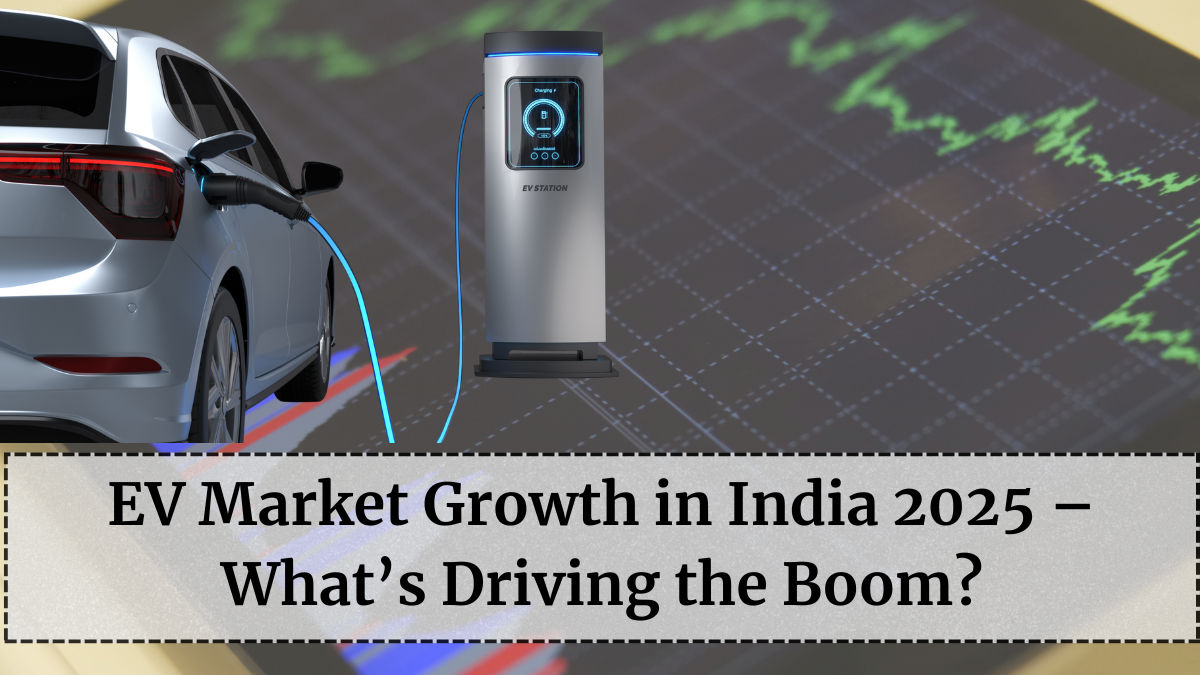The electric vehicle (EV) revolution in India has shifted into high gear in 2025. What began as a niche market driven by government incentives and early adopters has now become a nationwide movement — spanning two-wheelers, cars, and commercial fleets.
Thanks to improved infrastructure, falling battery costs, and consumer awareness, India’s EV industry is now one of the fastest-growing in the world. Let’s look at what’s driving this extraordinary boom in 2025 and how the Indian EV landscape is transforming.

Overview of India’s EV Market in 2025
India’s EV market is expected to reach a valuation of ₹1.5 lakh crore ($18 billion) by the end of 2025. According to the Ministry of Heavy Industries, total EV sales (across all segments) are projected to exceed 2.5 million units this year — a 60% jump from 2024.
Segment-Wise Breakdown:
-
Two-Wheelers: Dominating the market with over 70% share due to affordability and ease of charging.
-
Three-Wheelers: Rapid growth in e-rickshaws and cargo vehicles, now accounting for 20% of total EVs sold.
-
Passenger Cars: Witnessing record demand with models like Tata Punch EV, MG Comet, and BYD Atto 3.
-
Commercial Vehicles: Adoption in delivery fleets and buses driven by logistics companies and state transport departments.
By 2030, India aims for 30% electrification of all vehicles, with 80% of new two- and three-wheelers going electric.
Key Drivers Behind the EV Boom
1. Strong Government Support
The Indian government’s push for electric mobility remains the biggest catalyst. Programs like FAME-II, PLI for Advanced Chemistry Cells, and state-level EV policies offer subsidies, tax exemptions, and road tax waivers.
In 2025, the FAME-II scheme was extended till 2026, adding incentives for battery recycling and charging infrastructure expansion.
2. Growing Charging Infrastructure
India’s public charging network has surpassed 20,000 stations, with a focus on urban centers, highways, and logistics corridors. Companies like Tata Power, Statiq, ChargeZone, and Ather Grid are deploying fast chargers compatible with multiple EV brands.
Additionally, residential societies and workplaces are rapidly adopting shared charging solutions, supported by DISCOM rebates and GST reductions on equipment.
3. Technological Advancements in Batteries
Battery prices have dropped by nearly 30% since 2020, while energy density and lifespan have doubled.
2025 also marks the emergence of solid-state batteries, which are safer and offer 30–40% higher range compared to lithium-ion models. Companies like Ola Electric, Exide Energy, and Amara Raja are investing in gigafactories under India’s PLI scheme for domestic battery production.
4. Rise of Affordable EV Models
Previously, high upfront costs kept many buyers away. In 2025, new models under ₹10 lakh — including the Tata Tiago EV, MG Comet, and Ola S1 Air — have made EVs mainstream.
Low-cost financing, zero-down-payment loans, and exchange bonuses have also encouraged middle-class buyers to switch to electric.
5. Corporate and Fleet Electrification
E-commerce giants like Amazon, Flipkart, and Zomato have pledged full EV-based deliveries by 2030. This corporate adoption has accelerated bulk demand for electric two- and three-wheelers, along with charging hubs near warehouses.
Fleet operators are also benefiting from lower running costs — around ₹1/km compared to ₹8–₹10/km for petrol fleets.
6. Environmental Awareness and Fuel Costs
Rising petrol and diesel prices have nudged consumers toward sustainable alternatives. Urban users, in particular, view EVs as not just cost-effective but also eco-responsible choices aligned with India’s climate goals.
With Indian cities ranking among the most polluted globally, government-backed initiatives like “Switch Delhi” and “Go Electric” are raising awareness about EV benefits.
State-Wise EV Growth Leaders in 2025
| State | Highlights |
|---|---|
| Maharashtra | Leading in EV sales with major incentives and charging infrastructure. |
| Delhi | Highest adoption rate due to subsidies, tax waivers, and scrappage benefits. |
| Karnataka | Home to several EV startups and battery manufacturing units. |
| Tamil Nadu | Emerging EV hub with major investments from Ola Electric and BYD. |
| Gujarat | Rapid charging infrastructure expansion and industrial EV usage. |
These states collectively contribute over 70% of India’s EV sales and attract global manufacturers for localization.
The Role of Startups and Innovators
India’s EV ecosystem in 2025 is thriving with over 500 active startups working on vehicles, batteries, software, and energy solutions.
Notable names include:
-
Ather Energy – Pioneering high-performance scooters.
-
Ola Electric – Scaling EV and battery manufacturing.
-
Euler Motors – Building smart cargo EVs.
-
Log9 Materials – Developing fast-charging graphene batteries.
-
BluSmart Mobility – Operating India’s first 100% electric ride-hailing fleet.
These companies are helping India leapfrog into a self-reliant EV future through innovation and local production.
Challenges Still Ahead
Despite the rapid progress, a few roadblocks remain:
-
Charging Availability in Rural Areas: Most stations are still concentrated in cities.
-
Battery Recycling Systems: Need stronger collection and reprocessing infrastructure.
-
High Import Dependence: Key materials like lithium and nickel are still imported.
-
Grid Load Management: Increased EV charging demands require smart grid modernization.
However, the government’s Green Hydrogen Mission and incentives for battery recycling and mineral exploration are addressing these gaps progressively.
The Future Outlook – India’s EV Decade
By 2030, India is expected to have over 10 million electric vehicles on the road, supported by domestic battery production and renewable-powered charging.
Experts predict that by 2027, EVs will reach price parity with ICE vehicles, eliminating the biggest barrier to adoption.
From daily commuters to delivery riders, the entire transport chain is moving toward zero-emission mobility. With combined efforts from the government, startups, and global investors, India is well on its way to becoming the world’s third-largest EV market by the end of this decade.
FAQs
How big is the EV market in India in 2025?
It’s projected to cross ₹1.5 lakh crore ($18 billion) in value with over 2.5 million units sold across all segments.
Which EV segment is growing fastest in India?
Two-wheelers dominate the market with over 70% share, followed by e-rickshaws and compact four-wheelers.
What government incentives are available for EV buyers?
Buyers enjoy FAME-II subsidies, GST cuts (5%), road tax waivers, and up to ₹1.5 lakh tax deduction on loan interest under Section 80EEB.
Are electric cars affordable in 2025?
Yes, new models like the Tata Tiago EV and MG Comet are priced under ₹10 lakh, making EVs accessible to middle-income buyers.
What’s next for India’s EV industry?
Expect FAME-III, large-scale battery manufacturing, better recycling, and rapid rural EV adoption by 2027–2030.
Click here to know more.
